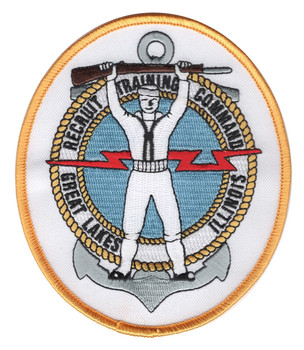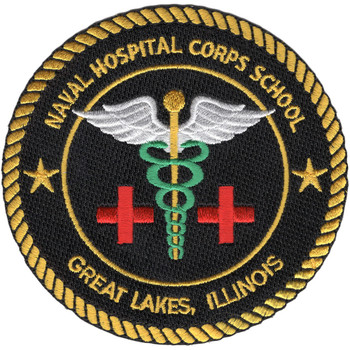Description
Great Lakes Illinois Naval Recruit Training Command Patch (U.S. Navy) 3.5" x 5" Embroidered Patch with Iron-On Backing
Superior Materials: Made with premium polyester thread and durable twill fabric, ensuring long-lasting color and strength.
Advanced Embroidery Technology: Crafted using the most advanced embroidery machinery, guaranteeing intricate detail, sharp lines, and consistent quality every time.
Easy Iron-On Application: Features a heat-activated adhesive backing for quick, no-sew attachment. Simply position, iron, and press for a secure bond.
Versatile Use: Perfect for personalizing jackets, backpacks, uniforms, or any fabric surface that needs a touch of personality.
Formations & Origins
The Great Lakes Illinois Naval Recruit Training Command (RTC) patch is a symbol of one of the most iconic military training centers in the United States — the Navy's primary boot camp, located at Naval Station Great Lakes, Illinois. Established in 1911, RTC Great Lakes has been the starting point for hundreds of thousands of sailors entering the U.S. Navy. It serves as the entryway into naval service, where recruits undergo rigorous training, testing their physical, mental, and emotional stamina. Located on the shore of Lake Michigan, the base earned its place as the Navy's largest recruit training installation, training sailors in both peacetime and wartime. The patch represents the completion of boot camp — the first significant milestone in a sailor's career.
Notable Commanders
Though the RTC at Great Lakes doesn’t have a single “notable commander,” it has been overseen by numerous figures who played a significant role in shaping naval training. One notable figure from the base’s long history was Rear Admiral William J. “Bill” Flanagan, who, in the early 1990s, helped drive modernization efforts to better prepare recruits for the complex realities of naval warfare. The base also became the site for Admiral William H. McRaven’s Navy SEAL training videos that gained attention for their emphasis on mental toughness and perseverance, setting a higher bar for recruits entering the service. The RDCs (Recruit Division Commanders) stationed here, however, are the true backbone of RTC, each one a fierce and dedicated leader who transforms raw civilians into sailors capable of serving the United States Navy.
Major Campaigns/Operations
While the RTC itself is not directly involved in combat operations, its legacy is intertwined with every major naval campaign the United States has participated in, since nearly every sailor who fought in those campaigns passed through its gates. During World War II, for example, Great Lakes processed thousands of sailors, quickly preparing them for service in the Pacific and Atlantic theaters. The training center remained pivotal during the Korean War, Vietnam War, Desert Storm, and through the Global War on Terror. Modern-day sailors who serve in high-profile operations such as those in the Middle East, the Pacific, and beyond also trace their origins back to Great Lakes, where they first stood on the grinder, ready to serve.
Specialized Role/Equipment
RTC Great Lakes is known for its comprehensive and physically demanding training programs, which are designed to prepare recruits for nearly every aspect of naval life. The training involves both academic and hands-on experiences — from learning to fire weapons and understand naval terminology to mastering swimming and survival tactics. Great Lakes also boasts one of the Navy’s largest and most impressive training facilities, complete with a firing range, a physical fitness course, a parade field, and classrooms dedicated to each sailor’s specific role in the Navy. The recruits are taught using a combination of Navy-issued equipment and training tools, including firearms, firefighting gear, and survival equipment. The training pushes recruits to their limits, and every step of the process is geared toward making them not only physically capable but mentally ready for the Navy's demands.
Acts of Heroism
While RTC Great Lakes is a training ground rather than a combat zone, the sacrifices and acts of heroism that occur within its walls are just as significant. For some recruits, boot camp represents the first time they’ve had to push past their limits. The mental and physical hurdles overcome here lay the foundation for the valor that will be required of them in combat. The stories of recruits who, in the face of exhaustion, fear, or doubt, continue to push forward, represent a kind of heroism that shapes future naval leaders. Additionally, many RDCs (Recruit Division Commanders) are known for their dedication to helping recruits reach their potential, sometimes taking extra steps to ensure that struggling recruits don't give up on themselves. These acts of mentorship and selflessness have had lasting impacts on generations of sailors who would go on to serve honorably.
Legacy & Notable Achievements
RTC Great Lakes has been responsible for turning ordinary civilians into the Navy’s most disciplined and capable sailors for over a century. The patch symbolizes not just the completion of boot camp but the beginning of a sailor’s military career — a career that will likely take them to the farthest corners of the world. From the training given during World War II, where the Navy prepared an entire generation to fight in the Pacific, to the present day, where recruits are taught modern naval combat and operational readiness, the RTC patch represents the U.S. Navy's commitment to excellence and to maintaining the best-trained fighting force in the world. The base has adapted over time, constantly improving its facilities and curricula to meet the changing needs of the Navy. Its impact is immeasurable — every ship, every submarine, every SEAL team, and every special operations unit in the Navy has seen recruits come through this base. The patch serves as a badge of honor for those who have made it through the demanding training process and are now ready to serve and defend their country on the high seas.
Durable and Washable: Designed to withstand everyday wear and occasional washing without fading or fraying.







